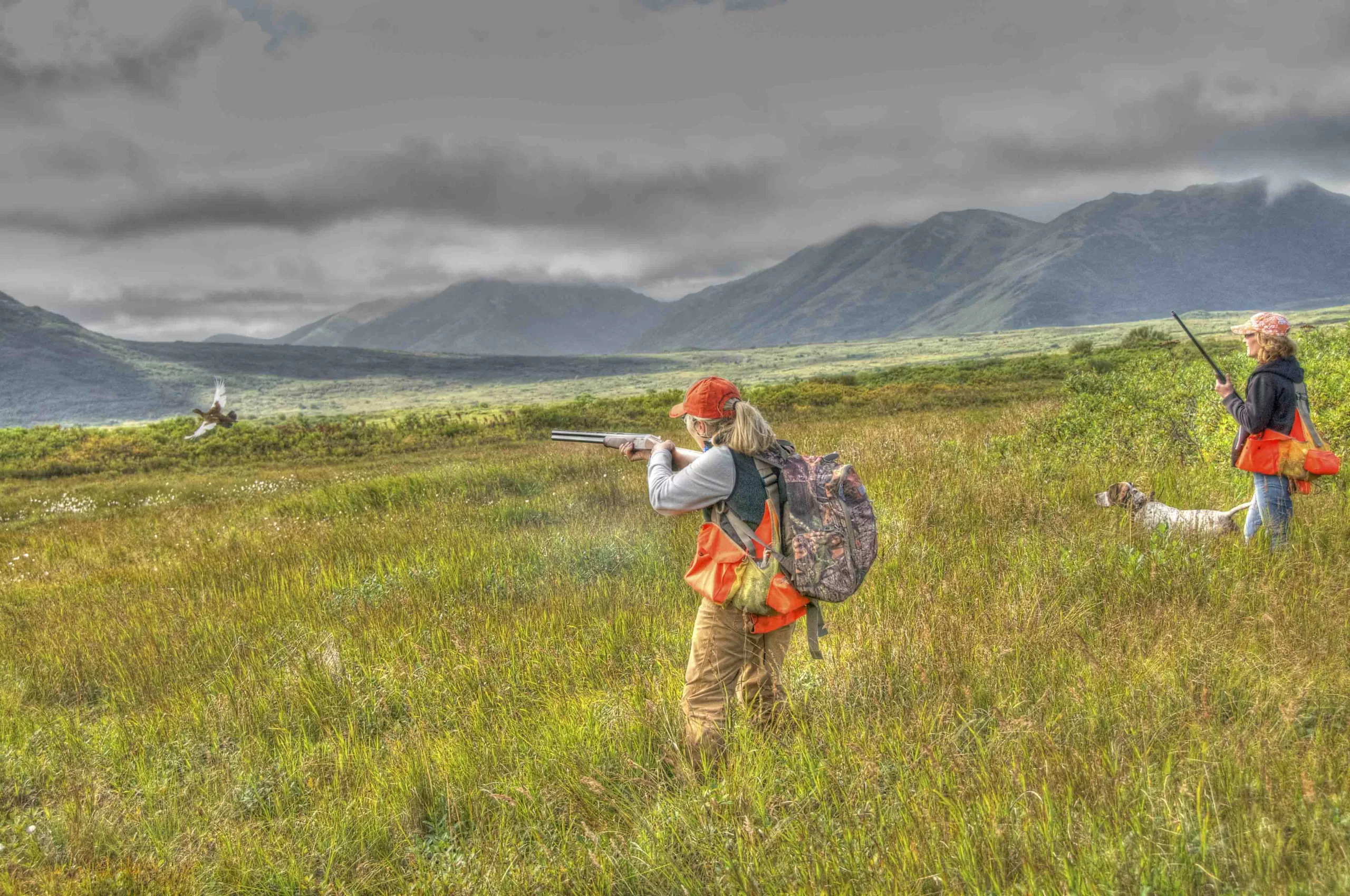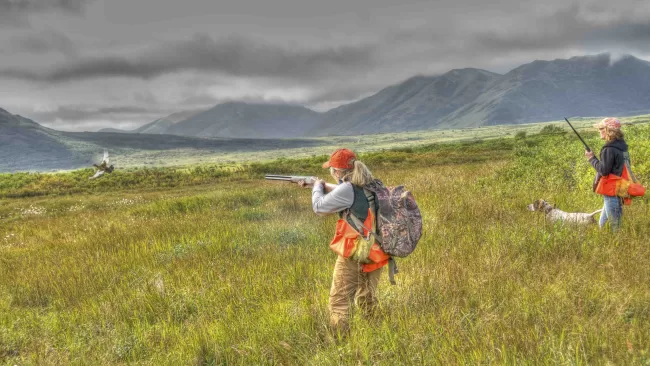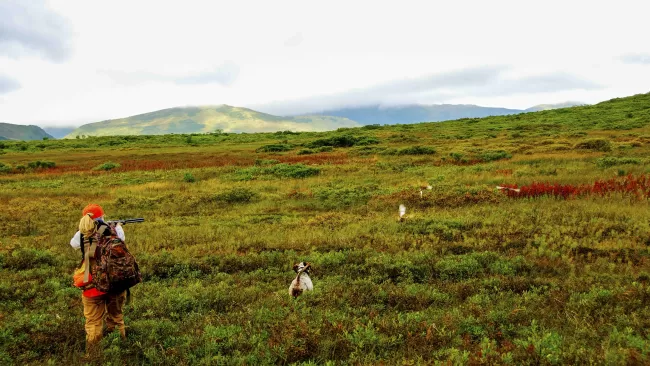Ptarmigan and Pointers on the Alaska Tundra
By Don Thomas | Photos by Lori and Don Thomas
Editors Note: As ptarmigan season starts to open up in various game management units across the Alaskan landscape, we thought this piece by Don Thomas – originally published in Pointing Dog Journal and adapted for digital use by Strung Sporting Journal – would be timely, not only as a source of reference, but also as entertainment and sheer good reading, for which Don Thomas is renowned. Note that the season on Ptarmigan is by game management unit – be sure to look up specifics before venturing out (as a reference, here are the 2024-2025 regulations).
Alaska’s Tundra Landscape – Ideal Ptarmigan Habitat
In Alaska, getting there is half the fun… at least in theory. As the fog burned slowly from the surface of the Naknek River, my wife Lori and I helped our old friend Dan Michels top off the fuel tanks in the Beaver and coax Max, his German wirehair, up the steps and into the back of the airplane. By the time we’d finished all our pre-flight chores, the last of the fog had dissipated. A few minutes later we were lifting off the river and heading south into the heart of more wilderness than most residents of the Lower-48 could ever imagine.
Indeed, wilderness isolation and gorgeous tundra terrain form an integral part of ptarmigan hunting’s appeal. In the era of locked gates and trespass fees “Outside”, roadless Alaska’s all but infinite horizons still promise ambitious hunters more cover than they can walk in a day, a week, or a lifetime, all free of fences and offering no one to object to your presence but the bears.
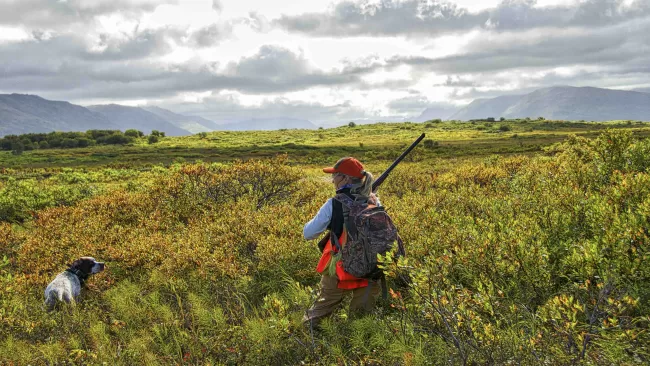
Thirty minutes later Dan had the flaps down in preparation for landing on a nameless pond in the middle of nowhere. I liked what I saw from the right seat: long miles of low tundra ridges that promised dry footing and held just enough willows to provide birds with cover without obligating us to bust through any brush. Factor in clear skies overhead and tundra foliage aglow with the blush of autumn and I couldn’t imagine a more promising beginning to a hard day of bird hunting, Alaska style.
After securing the Beaver, we climbed the first low ridge and fanned out behind Max in a pitch-perfect rendition of what our British counterparts would call rough shooting. Bristol Bay ptarmigan are funny, unpredictable birds. Sometimes I’ve found them so thickly concentrated that I didn’t have to go more than a few hundred yards from the airplane before I’d killed as many as I wanted or ran out of shells. Then there were days when I had to gird up my loins and cover some serious country just to watch a few flush out of range. When no warning clucks greeted us as we topped the first rise, we set out to earn our ptarmigan the old fashioned way: by walking.
A Digression about Caribou Habitat…
Fortunately, despite the countless time I’ve spent out in the Bush I’ve never lost my fascination with tundra habitat. As we hiked, I pondered a mystery that had long left me perplexed: the near total disappearance of the Upper Peninsula caribou herd. When I lived in Alaska fulltime during the 1980’s I hunted this country hard for caribou. Even though I limited myself to a traditional longbow I seldom came home without a good bull, often after glassing thousands. Then a decade or so ago, they simply vanished. As I walked along behind the wide-ranging dog, I studied the “reindeer moss” (it’s actually a lichen) that appeared as irregular yellow patches against the green and crimson ground cover. Although vital to the caribou, the stuff underfoot all looked sparse and skimpy compared to its exuberant, leafy appearance as I remembered it from years ago. Therein, I concluded, lay the explanation for the caribou’s sudden disappearance, and I found myself agreeing with the biologists who felt that the once rapidly expanding herd had simply eaten itself out of house and home.
But leave it to bird dogs to interrupt my deepest thoughts… “Point!” Dan cried suddenly, and when I looked up I spotted Max locked up tight as a tetanus victim beside a low clump of willows a hundred yards away. Ptarmigan destined to flush wild—more on this subject later—usually do so at once, and since we’d neither seen nor heard any birds in the air I guessed that whatever Max was pointing would hold tight while we approached. And indeed it did.
By the time the three of us reached him, the dog still stood motionless and quivering as if the willow clump had hypnotized him. When I finally waded into the brush in front of him, the deep, reedy chuckle of unhappy ptarmigan spilled across the tundra and then white wings were flashing everywhere. Gentleman that I am, I conceded the nearest bird to Lori while another 20-gauge barked off to my left. The little flock left me with an easy double, by which time we had enough birds down that I didn’t bother to reload for stragglers.
By the time Max finished cleaning the birds off the tundra I felt rejuvenated and ready to start walking again. And why not? We could walk all week without running out of bird cover.
Alaska Ptarmigan
Shortly after Alaska stopped being a territory, its schoolchildren conducted a poll to determine their new state bird. The choice they made—Lagopus lagopus, the willow ptarmigan–stands as a testimonial to the wisdom of the young.
There are actually three ptarmigan species native to the state, of which the willow—the same bird that adorns the Scotch label and the subject of all the Glorious Twelfth excitement in the British Isles–is by far the most widely distributed. The range of the white-tailed ptarmigan is largely confined to alpine regions of the Southeastern panhandle, and I’ve killed some there, mostly with bow and arrow while hunting big game in the backcountry. The rock ptarmigan’s range overlaps the willow’s in South-Central Alaska, but its preference for barren, rocky habitat at high elevations makes it a more difficult quarry to pursue. For regulatory purposes the state treats them all the same, which is fortunate since it can be difficult to identify individual specimens by species when the bird is resting in your hand, let lone on the wing at shotgun ranges.
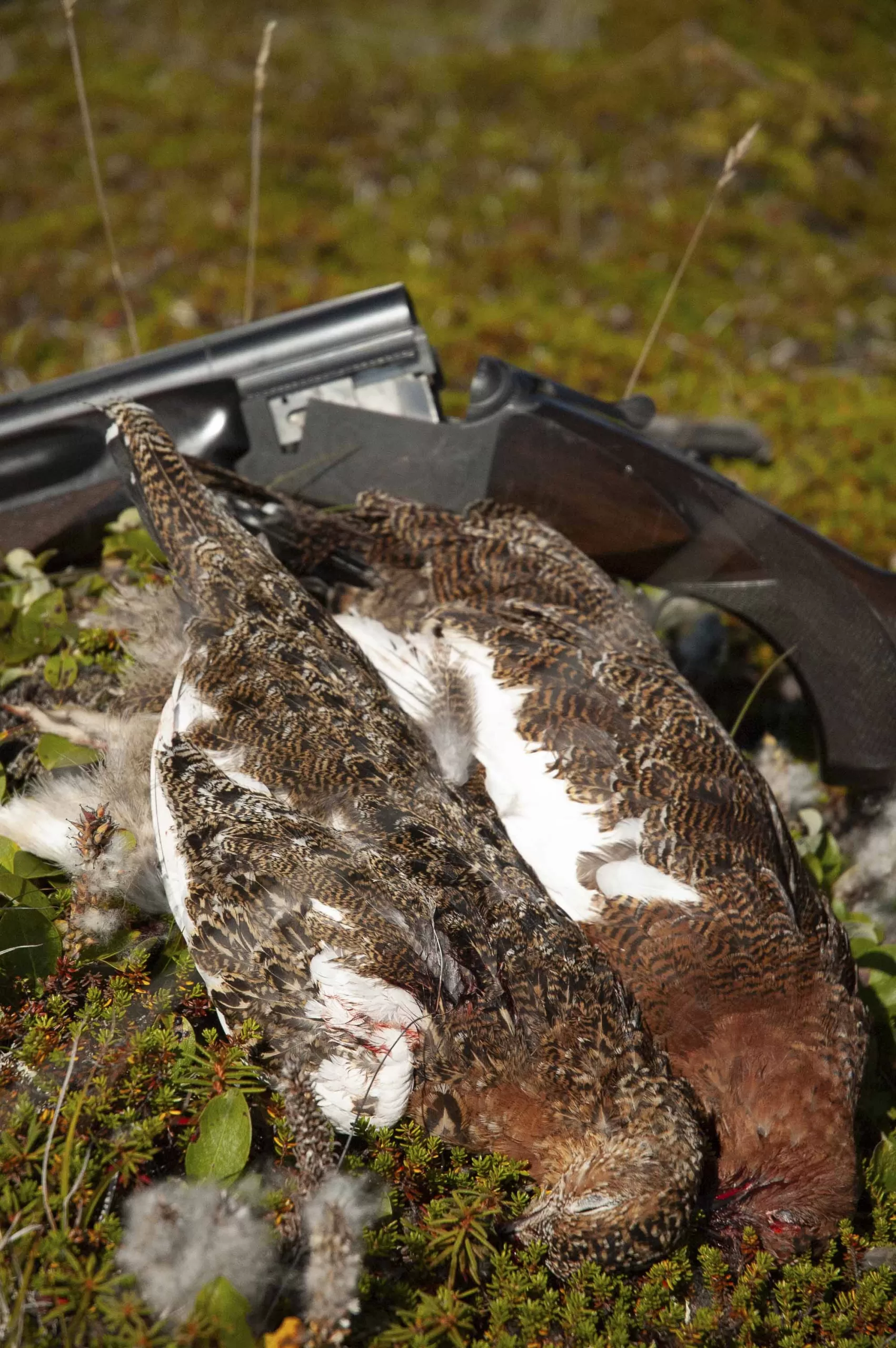
In the Bush, hunting pressure has virtually no impact on ptarmigan numbers, and the state recognizes this fact with generous seasons and limits—as high as 40 birds per day in some remote northern Game Management Units. In occasional Lord Ripon moments I’ve killed 20-bird limits farther south, only to be reminded that carrying out a backpack full of dead ptarmigan isn’t a whole lot easier than carrying out a backpack full of dead moose.
From the wing-shooter’s perspective ptarmigan demonstrate a wide range of behavior throughout the course of the season, in many ways similar to that of the sharptail grouse, a close biological relative. When hunting season opens in early August, birds are still organized in family groups and dressed in their summer plumage, which provides some of the best natural camouflage imaginable. When approached they’ll often hide rather than flush, and even in sparse open tundra it’s often possible to step right over them absent a canine nose to locate birds. Close, controlled shots are the rule as long as you can find the ptarmigan, which often first betray their presence with a characteristic alarm cluck.
By late August and early September—my favorite time to hunt them—birds may still be in family groups of 6 to 10, but some will have started to congregate in the large flocks that will see them through the winter. Their tolerance for dogs and people becomes unpredictable, with some groups continuing to hold tight while others flush far beyond shotgun range. By this time ptarmigan have started to transition into their snowy winter plumage, and the sight of dozens of white wings flashing across the tundra is one of the most compelling in the world of upland hunting.
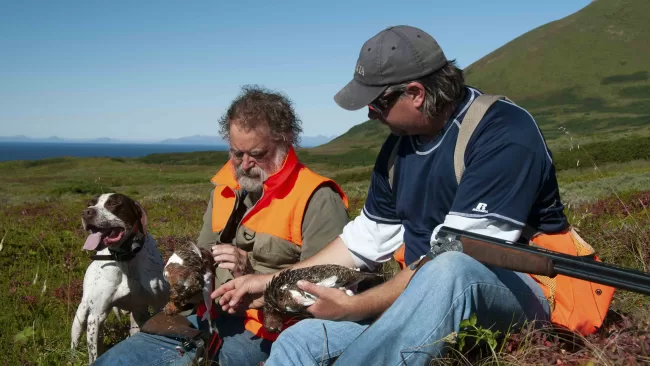
For obvious reasons few readers will choose to visit Alaska to hunt ptarmigan once the snow has started to fly, but winter hunting is still worth mentioning just because it can be so interesting. Back when I lived on the Kenai Peninsula my standard mid-winter cabin fever antidote was to load the dog into the Super Cub, fly across Cook Inlet, and land on skis once I’d located a concentration of ptarmigan—or their tracks, which were often easier to spot from the air than the birds themselves. The resulting hunt, often conducted on snowshoes, could produce anything from furious shooting to maddening frustration as hundreds if not thousands of pure white birds erupted from the willows beyond shotgun range.
Pointers – The Elegant Way to Hunt Ptarmigan
The dogs I used to load into my Super Cub back in the day were all Labrador retrievers, simply because that’s what occupied my kennel back when I lived in Alaska. And they were useful, locating tight-sitting early season birds and nosing them into the air, diving into the brush to bust out reluctant stragglers, and practically guaranteeing that I could hunt all season without losing a bird. Nonetheless, I always had the feeling that I was missing something, and I was right.
A few years back I finally accepted an invitation from friends to hunt ptarmigan over their English pointers, and that experience altered my whole approach to ptarmigan hunting. Open tundra terrain provides an ideal venue to watch pointing dogs at work. Birds that hold as well as early season ptarmigan deserve to be hunted with pointing dogs, whose mere presence in the field can turn long miles of hiking into an opportunity to participate in a classical, elegant drama. And after you’ve put a few miles of tundra behind you on foot, there’s nothing like letting the dog run up the next ridge to look for birds rather than running up it yourself.
I’ve hunted ptarmigan with several pointing breeds, and if the logistics of transporting a dog through the airline system weren’t so frustrating we certainly would have had Maggie, our own young wirehair, with us during our most recent visit to ptarmigan country. While I have no basis for recommending one breed over any other, I can describe the traits an ideal ptarmigan dog should demonstrate.
Ideal Traits of a Ptarmigan Dog
Pick a wide-ranging dog. Ptarmigan country is huge, often with few terrain or habitat features that reliably concentrate birds. The more ground your dog covers, the more shooting you’ll do. The dog will also need the stamina to hunt for several days in a row. The logistics of transporting bird dogs in the Bush often don’t allow the luxury of frequent rotations. Of course a good nose always helps, but this feature isn’t as critical as in some forms of hunting. Dogs seem to smell ptarmigan easily, and Alaska’s cool, damp hunting season climate usually produces ideal scenting conditions.
Above all, the dog must be staunch on point. If the dog is covering enough ground to find birds, it may be hundreds of yards away when it goes on point… and that distance my contain hills to climb, creeks to cross, and brush to bust. More often than not the birds will hold, if the dog gives them the opportunity.
Finally, the dog should come equipped with common sense. It’s one thing to run off and get lost in a South Dakota cornfield and quite another to run off and get lost on the Alaska Peninsula or Kodiak Island. Hunt ptarmigan country long enough and every dog will eventually run into a bear several sizes larger than anything it’s ever faced before. It’s difficult to predict how any dog will respond to a run-in with a bear, but if the dog is an aggressive scrapper, the first such encounter could well be the last.
Ptarmigan and Pointers on the Emerald Isle
On rare sunny days Kodiak Island can be a spectacularly beautiful place, alive with the lush, green foliage only constant weeks of warm rain can produce. That’s when its residents lovingly refer to their home as the Emerald Isle. The other 95% of the time, they call it the Rock. While I’ve endured my share of storm-lashed nights on Kodiak, luck was with us when Lori and I arrived that September. A high pressure system had cleared the skies, and as we landed in the little fishing town of Larsen Bay the Emerald Isle itself lay spread out before us.
We were traveling with another old friend, Lori Egge, a woman as remarkable as the setting. After years in the Alaska Bush aviation business during which she acquired a wide reputation for her piloting skills, she decided to meld her flying background with her passion for bird hunting and dog training. The result was Wingshooting the Wild, a customized hunting program that begins with Alaska ptarmigan in August and September, moves to Idaho for pheasants, quail, chukar, and Huns in October, and concludes with Georgia quail over the winter. She felt that Kodiak might provide a good September alternative to her August ptarmigan program in the Bristol Bay area and had asked us to accompany her on an exploratory trip to the area. (And yes the presence of two Loris together proved an endless source of confusion!)
The afternoon of our arrival, we loaded up Parker and Elvis, two of her best pointers, and set out to explore some possibilities close to our home base at Kodiak Lodge in Larsen Bay. Early afternoon found us hiking across a broad plateau overlooking the Karluk River, one of the most famous salmon and steelhead waters in the state. But just as I began to long for my fly rod, Elvis went on point and Parker moved in stylishly to honor him.
The birds held so well that I had to kick the grass to flush them while the two Loris did the shooting. With all due respect to the pointers that made it possible, the birds flapping on the tundra moments later made me long briefly for one of my Labs. But we quickly sorted out the confusion, and by the time we’d snapped a few photos and stored the birds in our game vests, Parker was on point again up the hill.
The daily ptarmigan limit on Kodiak is 20 birds, but none of us felt like shooting that many, let alone packing them home and cleaning them. We aimed instead for a more modest eight apiece—plenty to feed our friends waiting back at the lodge—and we had no trouble reaching that goal. We didn’t even bother shooting at the occasional bird that flushed spontaneously without a point from Elvis or Parker… we didn’t have to, and watching the dogs work was even more fun than the shooting.
We spent the next two days exploring new bird cover on Kodiak’s remote western end, by airplane and on foot. All of it held some birds, and most of it held a lot. Hooligan, Lori’s young female pointer, completed a three-dog rotation so that each of the dogs enjoyed a day of rest, which they needed even if they didn’t know it. We shot well, the lodge ate well, and everyone was happy. I even got to break out my fly rod during occasional breaks in the action.
And by the time we finally headed back home to Huns, sharptails, and Maggie, I was already thinking about ways to get my own pointing dog up north the following year.
A Few High Yield Notes About Hunting Ptarmigan in Alaska
Destination: Alaska
Season – In the productive Bristol Bay and Kodiak areas, ptarmigan season opens in August and runs longer than you want to be there. Alaska hunting regulations are complex and subject to change. Always consult current details (Alaska Department of Fish and Game) prior to hunting.
Delicious – Ptarmigan taken in August and September are delicious on the table, where they resemble early season sharptail grouse.
Ideal Gun & Shot – Ptarmigan are not hard to kill, and 20-gauge shotguns are perfectly adequate. I usually shoot 71/2 shot during the early season, although 6’s make a better choice once the birds grow spooky.
DIY enthusiasts certainly can find reasonable ptarmigan hunting from Alaska’s limited road system if they’re willing to do some hiking. However, in Alaska the hunting gets qualitatively better once you leave the roads behind no matter what the quarry. Furthermore, having your own aircraft on standby greatly increases your chances of finding birds in good numbers.
Don Thomas, Strung’s managing editor, grew up in an outdoor family and has been hunting and fishing for nearly 70 years. He has spent his adult life in Montana and Alaska working as a rural physician, and has also been a pilot, commercial fisherman, and bear hunting guide. He has hunted and fished on five continents, written over 20 books on the outdoors, and continues to write for multiple magazines. His latest book, “On The Wing” is a reflection upon his 60 year experience hunting upland game birds and waterfowl. The text includes insightful observations on wildlife biology and habitat. It includes a lot of informative stories and information about hunting dogs, especially Labrador retrievers and various pointing breeds. While much of the material focuses on his current home state of Montana, settings also include Alaska, the desert Southwest, and Texas as well as international destinations such as New Zealand and multiple locations in Southern Africa. The text is supplemented by 45 high quality color photographs. Find out more and purchase his books at https://www.donthomasbooks.com/

